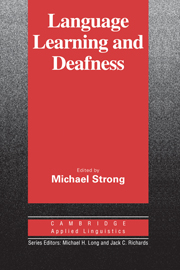Book contents
- Frontmatter
- Contents
- List of contributors
- Series editors' preface
- Preface
- SECTION I THEORETICAL ISSUES
- Chapter 1 Language varieties in the deaf population and their acquisition by children and adults
- Chapter 2 American Sign Language and the human biological capacity for language
- Chapter 3 The history of language use in the education of the Deaf in the United States
- Chapter 4 Sign language instruction and its implications for the Deaf
- Chapter 5 A bilingual approach to the education of young deaf children: ASL and English
- SECTION II RESEARCH REPORTS
- Index
Chapter 3 - The history of language use in the education of the Deaf in the United States
Published online by Cambridge University Press: 05 October 2012
- Frontmatter
- Contents
- List of contributors
- Series editors' preface
- Preface
- SECTION I THEORETICAL ISSUES
- Chapter 1 Language varieties in the deaf population and their acquisition by children and adults
- Chapter 2 American Sign Language and the human biological capacity for language
- Chapter 3 The history of language use in the education of the Deaf in the United States
- Chapter 4 Sign language instruction and its implications for the Deaf
- Chapter 5 A bilingual approach to the education of young deaf children: ASL and English
- SECTION II RESEARCH REPORTS
- Index
Summary
Editor's introduction
In Chapter 3 Lou takes a well-balanced look at language issues as they have influenced the education of deaf children over the past 170 years. In her review of the changes that have taken place in the educational use of language and mode, Lou details the struggles that persisted between advocates of oral and manual, English and ASL approaches, and that have finally come to a rather uneasy truce under the flag of Total Communication. Lou concludes, as do others in this volume, that no single method can fit all deaf children. In addition, Lou warns that Total Communication in name only is of little benefit to anyone, and that the real solution lies in a greater variety of alternatives provided by teachers who are capable of instruction in oral English skills, as well as, or alongside teachers with the ability to communicate in both signed English and ASL. This solution implies a greater use of deaf teachers, especially at the elementary level, an issue that is raised in Chapter 8. A true Total Communication program, Lou points out, should have the facilities for catering to the needs of individual students, including language and mode requirements together with audiological and speech therapy services. Such a program would be expensive and labor intensive and is simply not available under the current rubric of Total Communication. As a result, says Lou, the students suffer, and so does society.
- Type
- Chapter
- Information
- Language Learning and Deafness , pp. 75 - 98Publisher: Cambridge University PressPrint publication year: 1988
- 5
- Cited by



